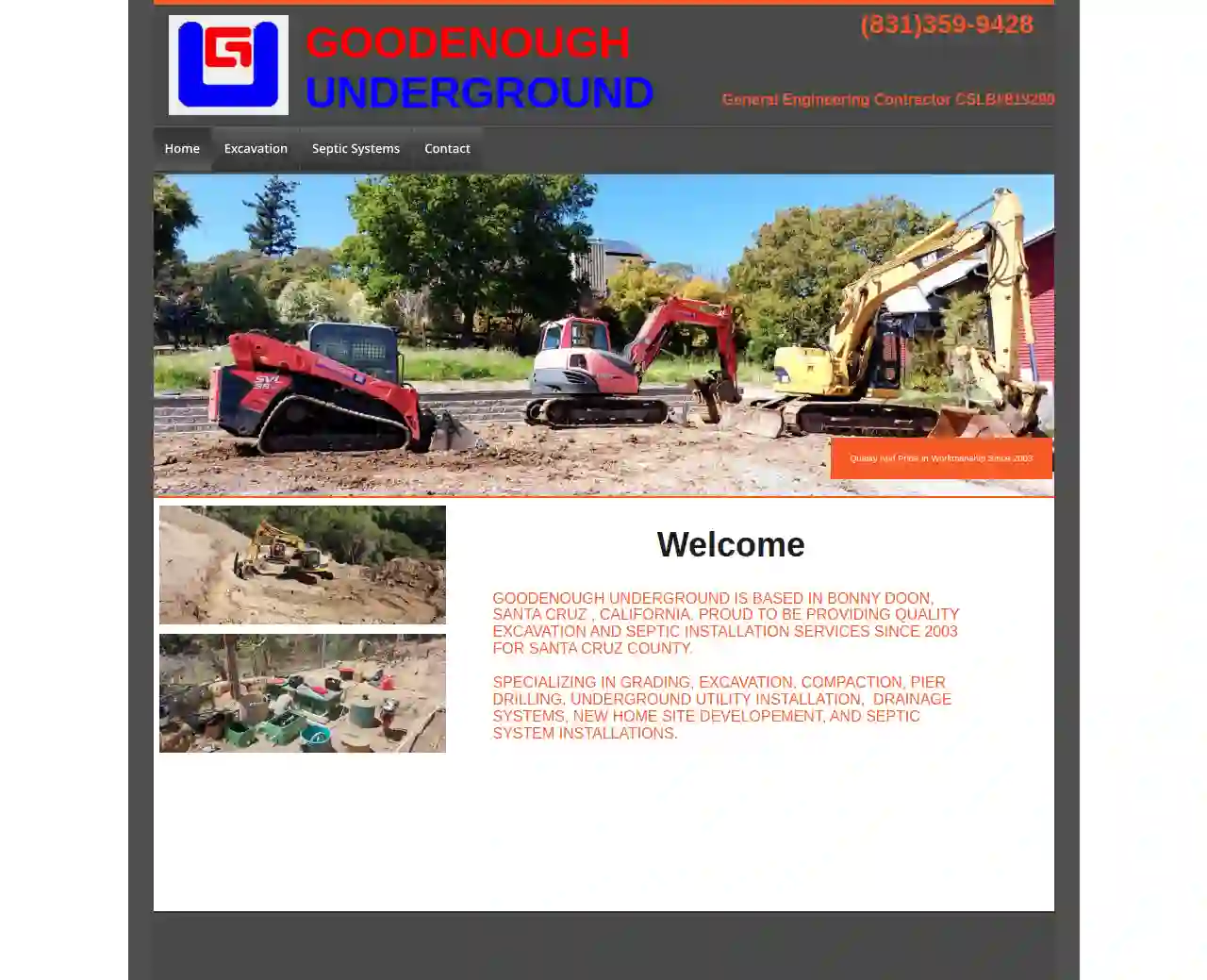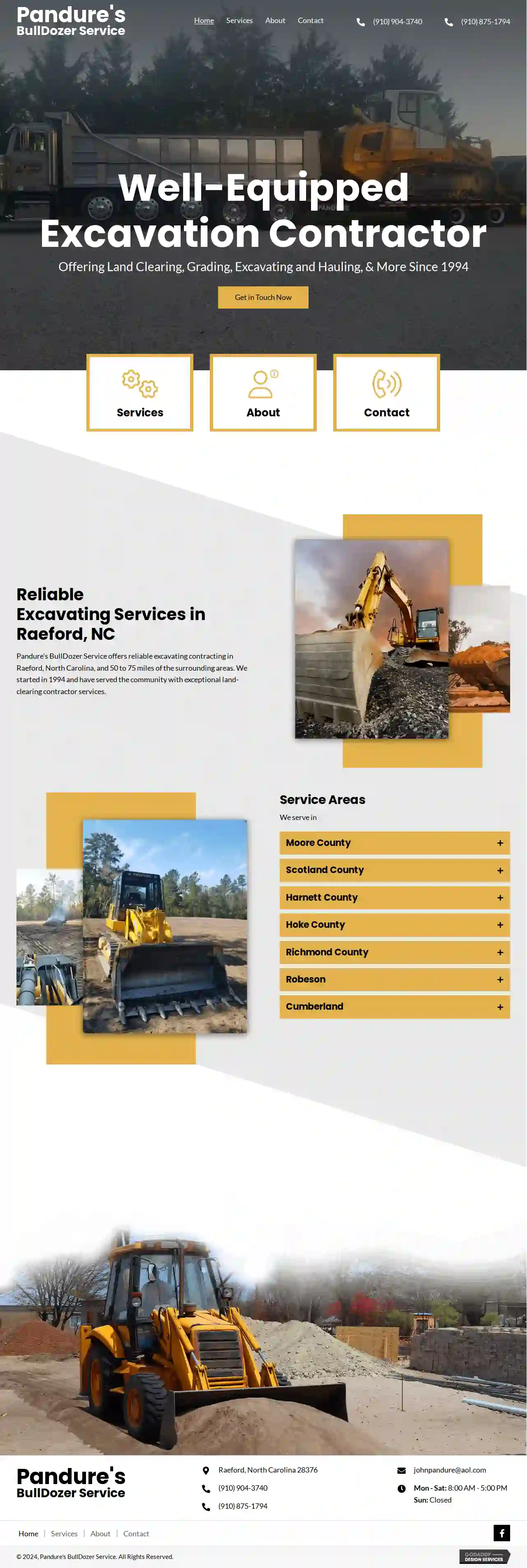Excavation Contractors Vacaville
Find Excavation Contractors Near Me in Vacaville
Receive up to 3 Excavation Company Near Me quotes for your project today! Compare profiles, reviews, accreditations, portfolio, etc... and choose the best offer.

GOODENOUGH UNDERGROUND INC.
57 reviewsBonny Doon, USGOODENOUGH UNDERGROUND IS BASED IN BONNY DOON, SANTA CRUZ , CALIFORNIA. PROUD TO BE PROVIDING QUALITY EXCAVATION AND SEPTIC INSTALLATION SERVICES SINCE 2003 FOR SANTA CRUZ COUNTY. SPECIALIZING IN GRADING, EXCAVATION, COMPACTION, PIER DRILLING, UNDERGROUND UTILITY INSTALLATION, DRAINAGE SYSTEMS, NEW HOME SITE DEVELOPEMENT, AND SEPTIC SYSTEM INSTALLATIONS.
- Services
- Why Us?
- Our Team
- Gallery
Get Quote
Excavating Contractor Los Angeles
59 reviewsLos Angeles, USWelcome to Bobcat Excavating Services Los Angeles As an excavation services and bobcat services provider in Los Angeles, we at BSLA – Bobcat Services Los Angeles help our clients with any processes that involve removal of earth from the ground, transfer of earth from one site to another, backfilling of earth to previously excavated spaces, and modification of sites to suite various clients’ needs. Are you building or remodeling your outdoor space? Chances are that we can be of help. If you searched for “excavators near me” for you got to the right place! We are experts when it comes to excavation, bobcat services, compacting, filling and grading. We work on residential sites, commercial sites, and industrial locations. We are licensed and insured and all our machine operators are vigorously skilled in handling our heavy machinery and providing precision results.
- Services
- Why Us?
- Gallery
Get Quote
Optimal EarthWork
51 reviews3070 Garden Ave, San Jose, 95111, USTransforming Landscapes with Precision: Earthworks Experts We harness the raw potential of the earth to create extraordinary transformations and deliver awe-inspiring results for every project we undertake. Excavation & Grading Swimming Pool Demolition Demolition
- Services
- Why Us?
- Accreditations
- Our Team
- Testimonials
- Gallery
Get Quote
Double Edge Construction Inc
1Irvine, USProfessional Construction Service At Double Edge Construction Inc., we are your trusted partner for high-quality construction and remodeling services in Orange County and the surrounding areas. Our expertise spans a wide range of services, including bathroom remodeling, kitchen remodeling, deck construction, foundation repair, and new building construction. We also specialize in water heater installation, seismic retrofitting, outdoor structure construction, and more. Our team of experienced professionals is dedicated to delivering top-notch craftsmanship and ensuring your complete satisfaction. Whether you’re looking to remodel your bathroom or kitchen, build a new deck, or undertake a full-scale construction project, we manage every aspect with precision and care. We take pride in our ability to bring your vision to life, from the initial design to the final touches. Double Edge Construction Inc. proudly serves communities throughout Orange County, including Tustin, Santa Ana, Orange, Irvine, Newport Beach, Laguna Beach, Costa Mesa, Anaheim, Fullerton, Mission Viejo, and beyond. Our local knowledge and commitment to excellence make us the ideal choice for homeowners and businesses in these areas. For reliable and professional construction and remodeling services, contact Double Edge Construction Inc. today. Let us help you turn your project into a reality with our seamless, hassle-free approach. Our Services Construction, Installations & Repairs
- Services
- Why Us?
- Testimonials
- Gallery
Get Quote
Land Clearing Group
55 reviewsOrange, USAbout The Land Clearing Group We help homeowners and businesses clear and prepare their property for the next phase of their project. Whether you need simple brush clearing or a total clear and site prep, we are here to help. Land Clearing Group is more than just a single company, we are composed of a large team of industry professionals that can handle any land clearing project; no matter the task. Our team of pros gives property owners a combined 50+ years of experience. We have worked in land projects across the state of Florida, Land Clearing Central Florida is quickly become the industry leader in customer satisfaction.Understand that this is our top priority on all land clearing solutions. Operating with such high corporate standards is not an easy task to achieve and can be solely attributed to the multiple professionals involved. Since the start of the company, we have operated on 3 principles which are visible on every project we do: We love this stuff! We will show up at each job: on time, ready to work and have fun. There will be crystal clear communication with the property owners at all times: before, during and after all projects. Your property will always be treated the same way we would treat our own property.
- Services
- Why Us?
- Gallery
Get Quote
Pandure's BullDozer Service
58 reviewsRaeford, 28376, USPandure's BullDozer Service: Your Trusted Excavation Partner Pandure's BullDozer Service is a family-owned and operated excavation and land clearing specialist based in Raeford, North Carolina. We've been serving the community since 1994, providing reliable and professional services for all your land clearing, grading, excavating, and hauling needs. Our team is comprised of skilled professionals with decades of experience in the industry. We are committed to delivering seamless, safe, and trustworthy services, always prioritizing transparency and working within your budget. Whether you need land leveling for a new construction project, demolition work to clear an existing structure, or expert grading and excavating services, we have the expertise and equipment to handle it all. We are proud to serve a wide range of clients, including builders, developers, and homeowners in Raeford and the surrounding areas. At Pandure's BullDozer Service, we are dedicated to providing exceptional customer service and exceeding your expectations. Contact us today to discuss your project and let us help you bring your vision to life.
- Services
- Why Us?
- Testimonials
- Gallery
Get Quote
Austin Enterprise
4.116 reviews1100 James Road, Bakersfield, 93308, USAbout Austin Enterprise For almost 30 years, Austin Enterprise has taken pride in having the best equipment and the best people to get any job done well and on-time. We employ 50+ employees and maintain a truck fleet of 40+ vehicles, ensuring that our customers can rest assured that they are getting quality work with the knowledge and experience of our teams to back it up. We’re proud to have been a CSDA member since 2010. Our mission is to be a professional specialty company. We take pride in ourselves, our company, equipment, and fellow employees. We strive to service our customers with quality service, provide well-trained employees, and maintain good working equipment. We aim to be the best in the industry, exceeding expectations and setting the standard for excellence. Patti Austin, the founder of Austin Enterprise, started the company in 1992 in Bakersfield, CA. Initially, Austin Enterprise focused on traffic control, providing highway construction signs. This early work allowed Patti to connect with other contractors working on highway projects. Through this networking, Patti identified opportunities to expand Austin Enterprise and added sawing and drilling to their list of services. Today, thanks to Patti’s dedication and hard work, Austin Enterprise has grown into one of the largest specialized highway rehabilitation contractors in California, with 47 trucks and over 50 employees. Austin Enterprise is a woman-owned business.
- Services
- Why Us?
- Our Team
- Gallery
Get Quote
Regier Construction Company
1PO Box 6084, Visalia, 93290, USOUR MISSION Quality and dependability are at the forefront of everything we do at Regier Construction. Our mission is for every one of our clients to experience transparency and top-notch customer service. Based in Visalia, California, and with over 13 years of industry experience we are pleased to offer commercial and residential services including, but not limited to, septic inspection, installation, and repair, excavation and grading, underground wet utilities, concrete, and more. We look forward to applying our expertise to your next project. General Engineering Contractor Lic. #1113926
- Services
- Why Us?
- Gallery
Get Quote
Sierra Construction
51 reviewsPO Box 5080, Sonora, CA, PO Box 5080 Sonora, 95370, USAbout Us We are an A and B licensed contractor located in Tuolumne County, CA. Our expertise is in grading and excavation. We offer high quality service for affordable prices that put us a step ahead of the competition. PROMPT AND RELIABLE At Sierra Construction our clients are our priority. We take pride in doing what we say we will do in regards to project timelines/budgets and we go the extra mile to make sure our customers are completely satisfied with our work. Call us today and find out what we can do for you.
- Services
- Why Us?
- Gallery
Get Quote
Bob's Landclearing
44 reviews2424 Mitchell Island Road, Deltona, USAbout Bob's Landclearing, Inc. Bob's Landclearing, Inc. is a locally owned and operated business with over 35 years of experience in the land clearing industry. We are dedicated to providing honest, reliable service that stands head and shoulders above the rest. Bob, a homegrown Florida boy, will engage in plain, straightforward, truthful, and honest communication. He and his son Justin, along with their experienced employees, focus on making you happy because your satisfaction is what they strive for. When your project is completed, we want to leave you with a smile on your face that says, “Job well done.” Our commitment is to ensure the full satisfaction of all our customers, no matter how small or big the job is. At Bob’s Landclearing, Inc., we take great pride in our services as well as our reputation. To Bob, word of mouth is very important, and a positive review is entirely based on your experience with us. We can promise that we will stay true to our strong values. That way, like so many of our past customers, you will be eager to work with us again.
- Services
- Why Us?
- Our Team
- Testimonials
- Gallery
Get Quote
Over 3,943+ Excavation Contractors on our platform
Our excavation pros operate in Vacaville and surroundings!
ExcavationHQ has curated and vetted the Best Excavation Contractors arround Vacaville. Find a top & reliable contractor today.
Frequently Asked Questions About Excavation Contractors
- Basement Size: The larger the basement, the more excavation is required, increasing the cost.
- Soil Type: Excavating rocky or dense clay soil is generally more expensive than loose soil.
- Accessibility: Difficult-to-access sites might require specialized equipment or more labor, driving up costs.
- Foundation Type: The chosen foundation type (full basement, crawl space, slab) affects excavation needs.
- Underpinning: If underpinning (strengthening existing foundations) is necessary, it significantly increases costs.
- Disposal Fees: Hauling excavated soil to disposal sites adds to the overall expense.
- Clear the Area: Remove any obstacles, including vehicles, outdoor furniture, landscaping features, or structures, from the excavation zone and surrounding area.
- Mark Existing Features: Identify and mark underground utilities, septic tanks, sprinkler systems, or other buried elements you want to protect.
- Protect Landscaping: Use tarps or fencing to shield trees, shrubs, gardens, or other landscaping elements from damage.
- Provide Access: Ensure the excavation contractor has clear access to the work area, including gates wide enough for equipment.
- Discuss Logistics: Coordinate with the contractor regarding parking arrangements, material delivery, and any special instructions or concerns you might have.
- Trench Collapses: Unstable trench walls can cave in, posing a severe risk to workers. Proper shoring and sloping are crucial safety measures.
- Utility Damage: Striking underground utilities (gas, water, electric) can cause leaks, explosions, or electrocution. Accurate utility locates and careful digging are essential.
- Falling Objects: Materials or equipment falling into excavations can injure workers. Securing work areas and using appropriate safety gear is vital.
- Equipment Accidents: Operating heavy machinery involves risks of rollovers, collisions, or mechanical failures. Trained operators and proper equipment maintenance are critical.
- Environmental Hazards: Excavated soil might contain hazardous materials (asbestos, lead). Proper testing and disposal procedures are necessary.
What is the difference between excavation and grading?
Excavation: Primarily involves removing earth or other materials from a site. It's about digging down and creating space.
Grading: Focuses on shaping and leveling the ground to a specific slope or elevation. It's about adjusting the existing terrain.
For example, you might excavate a foundation and then grade the surrounding area to ensure proper drainage and a level surface for landscaping.
How much does it cost to excavate a basement?
How do I prepare my property for excavation?
What are the risks associated with excavation?
What is the difference between excavation and grading?
Excavation: Primarily involves removing earth or other materials from a site. It's about digging down and creating space.
Grading: Focuses on shaping and leveling the ground to a specific slope or elevation. It's about adjusting the existing terrain.
For example, you might excavate a foundation and then grade the surrounding area to ensure proper drainage and a level surface for landscaping.
How much does it cost to excavate a basement?
- Basement Size: The larger the basement, the more excavation is required, increasing the cost.
- Soil Type: Excavating rocky or dense clay soil is generally more expensive than loose soil.
- Accessibility: Difficult-to-access sites might require specialized equipment or more labor, driving up costs.
- Foundation Type: The chosen foundation type (full basement, crawl space, slab) affects excavation needs.
- Underpinning: If underpinning (strengthening existing foundations) is necessary, it significantly increases costs.
- Disposal Fees: Hauling excavated soil to disposal sites adds to the overall expense.
How do I prepare my property for excavation?
- Clear the Area: Remove any obstacles, including vehicles, outdoor furniture, landscaping features, or structures, from the excavation zone and surrounding area.
- Mark Existing Features: Identify and mark underground utilities, septic tanks, sprinkler systems, or other buried elements you want to protect.
- Protect Landscaping: Use tarps or fencing to shield trees, shrubs, gardens, or other landscaping elements from damage.
- Provide Access: Ensure the excavation contractor has clear access to the work area, including gates wide enough for equipment.
- Discuss Logistics: Coordinate with the contractor regarding parking arrangements, material delivery, and any special instructions or concerns you might have.
What are the risks associated with excavation?
- Trench Collapses: Unstable trench walls can cave in, posing a severe risk to workers. Proper shoring and sloping are crucial safety measures.
- Utility Damage: Striking underground utilities (gas, water, electric) can cause leaks, explosions, or electrocution. Accurate utility locates and careful digging are essential.
- Falling Objects: Materials or equipment falling into excavations can injure workers. Securing work areas and using appropriate safety gear is vital.
- Equipment Accidents: Operating heavy machinery involves risks of rollovers, collisions, or mechanical failures. Trained operators and proper equipment maintenance are critical.
- Environmental Hazards: Excavated soil might contain hazardous materials (asbestos, lead). Proper testing and disposal procedures are necessary.